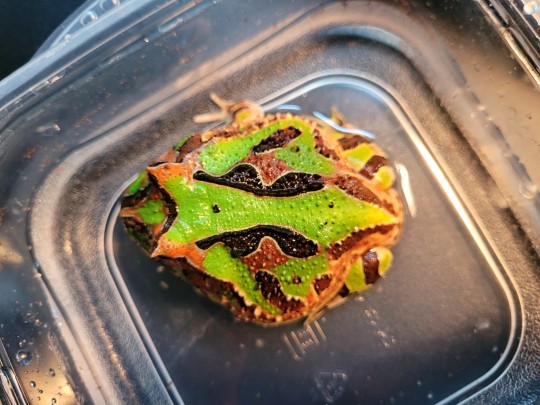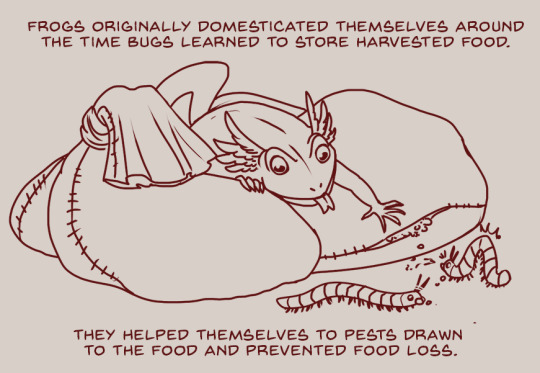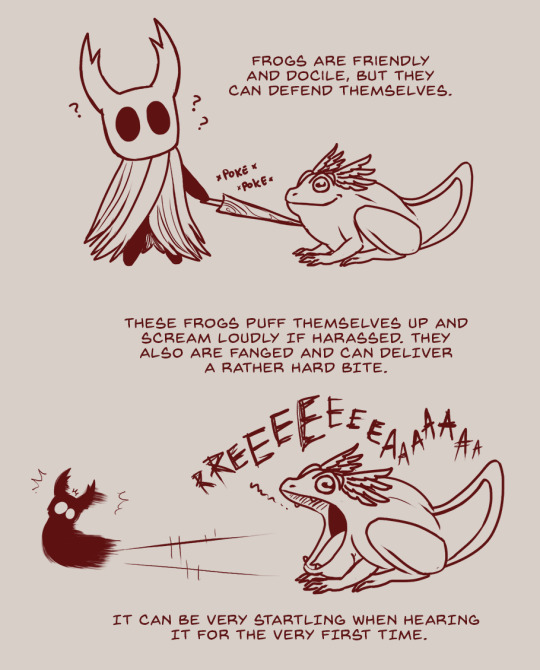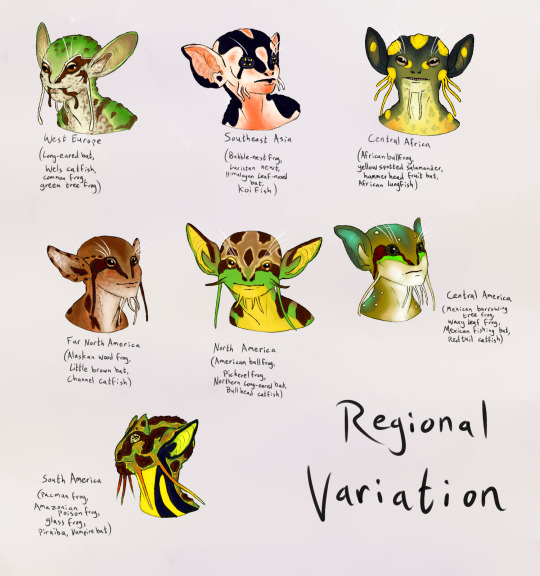#fantasy pacman frog
Explore tagged Tumblr posts
Text
Moss fairy checkup time!!





She peed so she's kind of deflated, rehydrating currently lol little piss balloon
I wash her off and stir her hovel so she doesn't get red leg from bacteria buildup and to check for poops
#moss fairy#potato fairy#piss balloon#fantasy pacman frog#pacman frog#froggy#froggie#froggo#frog#amphibian#amphiblr#frogblr#oc
79 notes
·
View notes
Text



Coco being a cutie pie
112 notes
·
View notes
Text

I simply love him
#frogposting#pacman frog#fantasy pacman frog#ceratophrys#ceratophrys cornuta#ceratophrys cranwelli#queue
6 notes
·
View notes
Text
I sincerely hope my fantasy pacman frog is sufficient for submission!

Day 146
Mystic Being
33 notes
·
View notes
Text
$15 Adopt!!!
Was gonna try to make her part of a set but gave up, so here is a fantasy morph pacman frog themed adopt

7 notes
·
View notes
Note
hi do u have any game recommendations for PC? can be any genre ^^ thank u!
Disclaimer: I don't play much anymore. When I do play games, I usually never finish them. ��� With that said, here are some recommendations.
Signalis
Metal: Hellsinger
Final Fantasy VII Remake
The Great Ace Attorney Chronicles
DOOM Eternal
Devil May Cry series
Bayonetta
Onimusha
Resident Evil Zero / RE1 Remake
Castlevania Advance Collection
A Hat in Time
Killer7
SpongeBob Rehydrated
Frog Detective
Nioh
Pacman World RePac
2 notes
·
View notes
Text
Horned Frogs: Masters of Camouflage and Ambush
In the world of amphibians, few creatures capture the imagination quite like the horned frog. Known for their distinctive appearance and unique behaviors, horned frogs, belonging to the Ceratophryidae family, are fascinating inhabitants of various ecosystems. This article will explore the characteristics, habitats, and intriguing features that make horned frogs a captivating subject in the realm of amphibians.

In the world of amphibians, few creatures capture the imagination quite like the horned frog. Known for their distinctive appearance and unique behaviors, horned frogs, belonging to the Ceratophryidae family, are fascinating inhabitants of various ecosystems. This article will explore the characteristics, habitats, and intriguing features that make horned frogs a captivating subject in the realm of amphibians.
I. Introduction to Horned Frogs
Horned frogs, also referred to as pacman frogs due to their resemblance to the iconic video game character, belong to the Ceratophryidae family. These frogs are native to South America and have gained popularity in the exotic pet trade due to their distinctive appearance and intriguing behaviors horned frogs cup.
II. Physical Characteristics: A Cloak of Camouflage
One of the most striking features of horned frogs is their appearance. Their bodies are broad and flat, resembling a leaf or a stone, providing excellent camouflage in their natural habitats. Explore the variations in colors and patterns that different species of horned frogs exhibit, ranging from vibrant greens to earthy browns.
III. Horned Protrusions: Defensive Adaptations
True to their name, horned frogs possess bony, pointed protrusions above their eyes, resembling horns. While these may look intimidating, their primary function is camouflage. However, when threatened, horned frogs can arch their bodies and raise these "horns," adopting a defensive posture to deter potential predators.
IV. Diverse Species: An Array of Horned Frog Varieties
The world of horned frogs is diverse, with several species exhibiting unique characteristics. Explore different species, such as the Argentine horned frog (Ceratophrys ornata), Cranwell's horned frog (Ceratophrys cranwelli), and the Fantasy horned frog (Ceratophrys hylandersi), each with its own set of colors and patterns.
V. Habitats: From Tropical Forests to Grasslands
Horned frogs inhabit a range of ecosystems, from tropical rainforests to grasslands and savannas. We'll delve into the specific environmental conditions preferred by different species, shedding light on how these frogs have adapted to diverse habitats.
VI. Dietary Habits: Ambush Predators of the Amphibian World
Horned frogs are renowned for their ambush predation tactics. Their diet consists mainly of insects, small mammals, and even other frogs. Explore how their patient waiting, aided by their excellent camouflage, allows them to strike swiftly and consume prey nearly their own size.
VII. Reproduction: Unique Breeding Strategies
The breeding habits of horned frogs are equally fascinating. We'll discuss their unique reproductive strategies, including the male's role in guarding the eggs and tadpoles, as well as the intriguing parental care exhibited by some species.
VIII. Life in Captivity: Horned Frogs as Exotic Pets
Due to their unique appearance and relatively straightforward care requirements, horned frogs have become popular choices in the exotic pet trade. Learn about the considerations and responsibilities involved in keeping horned frogs as pets, from creating a suitable habitat to understanding their dietary needs.
IX. Conservation Status: Challenges and Threats
While not all horned frog species are currently classified as endangered, some face threats due to habitat loss and the pet trade. Explore the conservation status of various horned frog species and the efforts being made to preserve their natural habitats.
X. Educational Importance: Studying Horned Frogs in Scientific Research
Beyond their roles in the pet trade, horned frogs contribute to scientific research. We'll highlight how these amphibians are valuable subjects in studies ranging from ecology to physiology, offering insights into broader aspects of amphibian biology.
XI. Cultural Significance: Folklore and Symbolism
In some cultures, horned frogs hold symbolic significance. Discover the folklore and cultural representations associated with these unique amphibians, exploring how they have become characters in stories and legends.
XII. Conclusion: Horned Frogs - Nature's Masters of Stealth
In conclusion, horned frogs stand out as remarkable creatures in the world of amphibians. Their unique appearance, ambush predation tactics, and adaptability to diverse environments make them both captivating subjects for enthusiasts and valuable contributors to scientific understanding.
1 note
·
View note
Text

New friend alert!
This is Nova, a fantasy pac man frog. I picked them up at an expo last weekend, and they seem to be acclimating well. (Burrowing in the dirt, as one does)

I can’t wait to watch them grow up! :)
22 notes
·
View notes
Text
Find the friend

1 note
·
View note
Photo

Worked out some colors.
15 notes
·
View notes
Text
My girl grunk on her way back to bed 💅



She's thriving I think despite brumating (input welcome on her body condition). She brumates regardless of enclosure temps above and below ground, even bumped the cool side to 75 F and hot side to 90 F to see if it would help and nah, sleeps regardless.

Despite me covering the lid gaps my former stray cat I wound up with ended up putting a foot through the lid on accident. She doesn't go after the reptiles, just walks across the enclosures sometimes. Had to make a makeshift one with some galvanized steel mesh temporarily until the new enclosure arrives. Took the opportunity to dig her up, give her a bath, stir the dirt, trim the plants, check on her belly... The lid is tied down, very sturdy.
6 notes
·
View notes
Text


Duality
#first pic is from a few days ago when she pooped and got energetic#she ate one fish after a lot of coaxing today and one pinkie#small victories#her boo-boo is almost healed too#coco the frog#frogs#amphibians#pacman frogs#fantasy pacman frog
3 notes
·
View notes
Text


It's Froggy Friday! Wonderful blue-eyed brothers, Beans and Fern, hung out and sat around.


Older brother Mr. Pickles later joined, while wearing his apple green coat of brotherliness. Now all 3 of the men are together!

I also want to introduce Nuggie, our 2 year old fantasy pacman frog. He sat in his dirt hole this week.
23 notes
·
View notes
Photo






SO I WAS TALKING the other day about a possible cat allegory for the Hollow Knight world. It’s based off the real world thing where some species of burrowing tarantulas will keep tiny frogs under their protection because the frogs eat the ants that targets their eggs. So I ran with it, especially since my waifu said she’d be a tarantula tiny frog breeder in this universe.
So like cats, I imagine frogs domesticated themselves. Once bugs got together and started to farm and store food, it would ultimately attract pests looking for an easy meal. Frogs noticed the congregation of prey items and moved into these stone silos and store houses. There they would devastate pests because if you ever owned a frog, you know they will eat until they can barely move. Sapient bugs are much too big to be threatened by these frogs, so they allowed them to stay and do the work for them.
Eventually they started getting into houses and into rooms where larvae and eggs are kept. Feral bugs who usually would prey on these eggs and helpless young would find themselves getting pounced on and eaten before damage could be done. Again, said eggs and larvae are too big for these frogs to prey on. If they are smaller it was learned that by bonding with them, they’ll recognize who is and isn’t food in a short while. They aren’t too smart, but they are smart enough for that at least.
They became companion animals and also started to be professionally bred in a wide array of colors and gill patterns. Some are large, some are bred to fit into tea cups. A lot of these very fancy breeds were lost when Hallownest fell, but the hardier stock closer to their original ancestors fared very well. Many of them became strays and they didn’t realize much of a difference, save for not being pet so much. They still are primarily working animals.
If you want to know what they sound like when startled, here you go. They scream like budgett's frogs which is hilarious.
youtube
Design wise I combined them with cave salamanders to give them a more fantasy flair and give them the traits needed for a mostly wet cavern. They can also secrete a mucus that makes them immune to acid if properly fed.
I imagine that Hollow would love these and be a magnet for them and be covered in happy little frogs that scream if you try to remove them.
(BTW my pet frog is named Dio cause he’s a little bastard and he’s a Strawberry Pineapple morph pacman frog. I adore him.)
#hollow knight#art#frogs#amphibians#keetah#ghost#don't poke the frog#world building#lore#speculation#the tiny frog pet industry#you better believe there were frog shows#frog conventions#frog pet stores#little suits made for frogs#they are cute#frogs are cats#domestication
516 notes
·
View notes
Note
Thank you so much!! I will definitely check those out and the Reddit c: and a clear indicator I need to do *way* more research—I didn’t know there were different species referred to as pacman frogs! Probably could have guessed what with tomato frogs but still :o I also got into the FB group so I look forward to lurking and learning C: thank you again <3
A LOT of people don’t know this, including some pacman frog keepers!
There are eight species, though only three regularly occur in captivity. The rest are only rarely found for sale or in private collections. Anything labeled as “fantasy” is a hybrid, usually of Ceratophrys cranwelli and cornuta.
Cranwelli is the most common species. They’re usually green with brown spots or brown all over. If it’s albino, it’s a cranwelli. If it’s pink, it’s a cranwelli. Almost any fancy morph that isn’t fantasy is a cranwelli. They’re the most common by a huge margin.
Ornata is the next most common. The “high red” morph is an ornata morph. They’re usually labeled as ornate pacman frogs. They’re typically brown, red, and green in various amounts. As the name suggests, high red ornatas have a lot more red!
Cornuta is the last of the common ones and not nearly as popular. They’re shades of brown and orange-y tan. They’re leaf mimics. However they also have the biggest pointiest horns and tend to get the biggest out of the three common species.
Aurita is much less common than even cornuta but Josh’s Frogs has them for sale with some regularity, so I’ve added them too.
The other species are almost never seen in the hobby but not totally unheard of :)
12 notes
·
View notes
Text
Goblin Color Variation
(Previous post on some basic anatomy things. Next post on goblin evolution and development)
My laptop is struggling but sometimes its nice to me long enough to get stuff done. Golly I can't wait for that new one.
Anyway, I made a bunch of goblin color variations just to show some of my thought process in designing individual goblins. These are all possible goblin skin patterns based on mixes of real amphibians, picking from different regions on earth. The fantasy world I've built is like earth-adjacent so it has similar continents, but I havent really named the countries yet so I default to real world names when I describe where these regional variations of goblins might be from. They're very generalized, but of course its pretty easy to get super specific too. And sometimes I just make up the coloration without any references to specific animals.

(Description: a digital picture of 7 different goblin portraits. Each is labeled with a real world region and a list of real life animals I used as inspiration. They all have different skin colors and patterns, different eyes and war shapes, and different arrangements of facial whiskers/barbels.)
and since a full detailed description is gonna require multiple paragraphs I am actually gonna go ahead and put the rest of this under a cut:
1: western europe. I combined the green tree frog coloration with the white belly and brown stripes and spots of the common european frog . They have bumpy skin, the brown and pale tan eyes of the common frog, ears like a long-eared bat, and barbels like a wels catfish: two long ones on the cheeks and four shorter ones spread along the chin.
2: southeast asia. They have white skin with gradient patches of bright coral orange, all surrounded by thick black markings on the face and body, like a Luristan newt. Their eyes are black with four yellow patches around the pupil like a bubble nest frog. Their ears resemble those of a Himalayan leaf-nosed bat, and they have the shorter barbels of a koi fish, two on each side of the jaw.
3: central Africa. They have the pale yellow to orange belly patch of an african bullfrog, with olive green speckles fading to the bumpy olive green skin on the sides. Their eyes are also from the African bullfrog, with beige on most of the iris and dark brown corners. Their skin fades into a dark grey on the top of the head and sides of the body, and they have multiple large yellow spots, inspired by the yellow spotted newt. Their ears are like those of a hammerhead fruit bat, and they have barbels like an african lungfish, three at each cheek and two on the chin.
4: far north america. This one is more specific, having the gradient of reddish brown to beige skin, reddish brown speckles faded between, and dark brown eye stripe of the Alaskan wood frog, with matching brown striped eyes. They have the ears of a little brown bat, and barbels like a channel catfish, two long ones at the cheeks and four smaller ones at the chin.
5: north america. From the top of their head to their eyes, they have the light brown skin of a pickerel frog, darker brown stripes and patches across the head and shoulders as well as coming off the matching brown striped eyes. From the eyes down, they have the green skin and yellow belly of an american bullfrog. Their ears match the northern long eared bat, and they have the barbels of a bullhead catfish, having two long ones at the cheeks, four short ones at the chin, and two more short ones higher on the cheeks.
6: central america. Mostly this goblin resembles a mexican burrowing tree frog, with brown skin and a dark reddish brown eye stripe with a bright green stripe below the eye. But their belly is pale and their skin fades to a light teal with pale yellow spots at the top of the head and along their back, to resemble the waxy leaf frog. Their eyes are also from the waxy leaf frog, being very dark grey with lots of tiny pale yellow streaks. Their ears are like the mexican fishing bat, and they have barbels like a red tailed catfish, two long ones at the cheeks and four medium length ones at the chin.
7: south America. They have the veye bumpy and mottled green, yellow, orange skin of a pacman frog, with several uneven dark brown stripes all over their head. Their eyes are white with black crackle lines, like the eyes of a glass frog. At their neck, thei skin coloration changes to bright yellow with a couple thick black stripes like a common amazonian poison frog. They have ears like a vampire bat and barbels like a piraiba, two very long barbels at the cheeks and four medium length barbels spread out over the chin. They are the only one without eyebrow whiskers because they have the tall triangular eyebrow ridges of the pacman frog.
60 notes
·
View notes